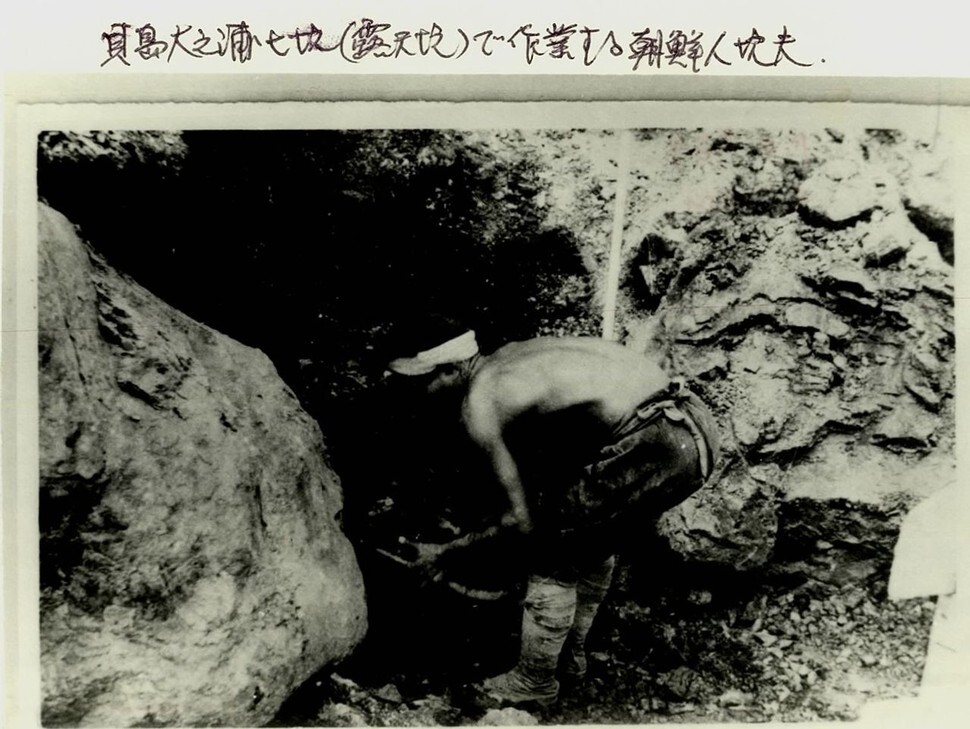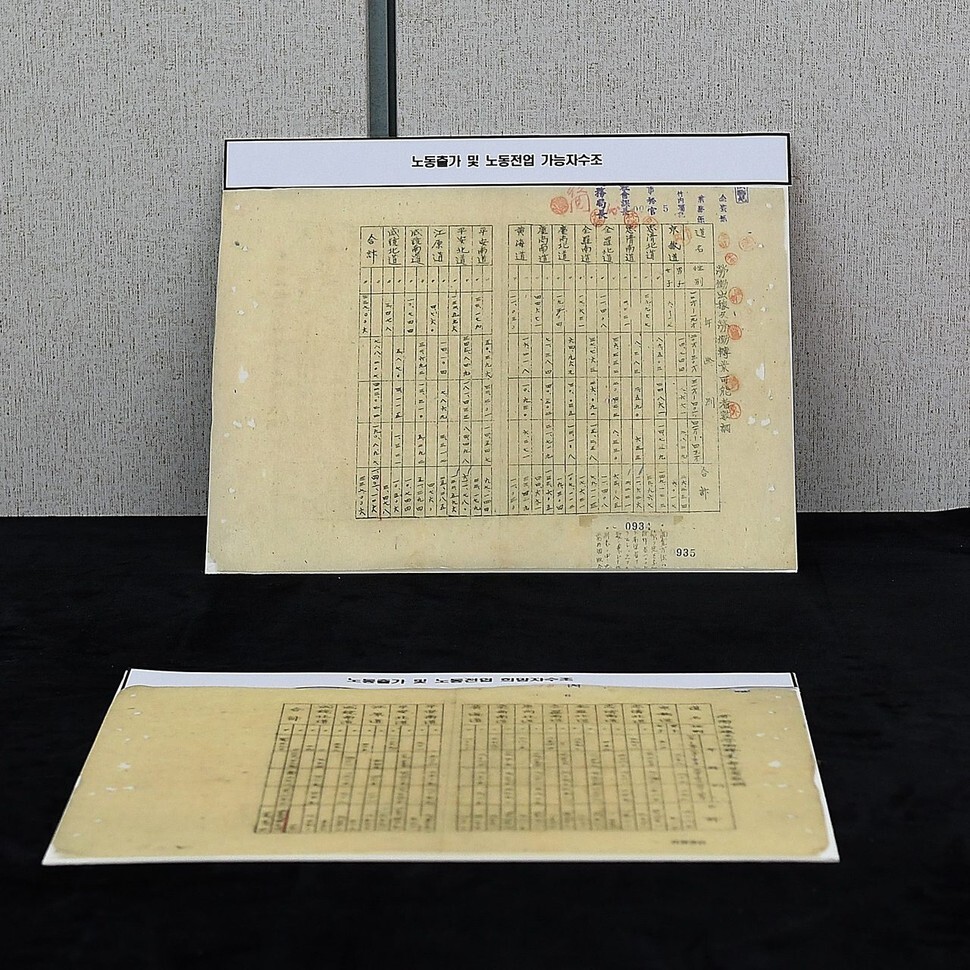hankyoreh
Links to other country sites 다른 나라 사이트 링크
Records of imperial Japanese workforce survey in 1940 revealed to public for first time

Records of an imperial Japanese workforce survey ahead of the Pacific War in 1940 showing a total of 1.16 million Koreans who were “eligible” for forced labor has been made public for the first time. Imperial Japan forcibly mobilized anywhere from 80,000 to 290,000 Koreans annually during and after the time of the survey. Korean women were restricted to those in their teens -- a decision seemingly based on their eventual drafting as comfort women under the Japanese military.
On Oct. 31, the National Archives of Korea (NAK, affiliated with the Ministry of the Interior and Safety) unveiled the original version of a March 1940 titled “Regarding the Labor Resource Survey,” produced by the office of the Governor-General of Korea. Also revealed were originals from among 2,337 records donated to the NAK in 2017 by the late Zainichi Korean researcher Kim Gwang-ryeol, including documents, photographs, diagrams, and other materials related to the forced mobilization of Koreans. While the records have been known to scholars, this marks the first time they have been shared with the general public.
According to the Governor-General of Korea’s “Regarding the Labor Resource Survey” document shared on Oct. 31, the number of Korean male workers aged 20 to 45 who were available for mobilization in 1940 was calculated at 927,536, while the number of female workers aged 12 to 19 was listed at 232,641, for a total of 1,160,177. This number represented around 5% of the total Korean population of 23,547,465 at the time. A total of 263,081 people were also listed as hoping to leave their homes to find different work, including 242,314 males and 20,767 females. Regarding the reason that females but not males were restricted to their teens, No Yeong-jong, a curatorial researcher at the NAK, said, “It may be that they had it in mind to mobilize them as comfort women to the Japanese military, or it may have been difficult to actually mobilize women in their 20s and older because most of them were married.”

The NAK explained that the survey was considered by imperial Japan during the Second Sino-Japanese War and ahead of the Pacific War to make preparations for the perceived need to forcibly mobilize Koreans in large numbers. Indeed, the number of Koreans listed in labor mobilization plans by imperial Japan rose sharply from around 85,000 in 1939, 88,800 in 1940, and 81,000 in 1941 to 130,000 in 1942, 125,000 in 1943, and 290,000 in 1944. The NAK believes the actual total of Koreans forcibly mobilized was even higher.
Originally in the possession of the Governor-General’s office, the document was transferred to the Kyujanggak archives at Seoul National University and on to the NAK after liberation. While the document was available to the public, it remained unstained due to a lack of researchers working on the labor mobilization issue and its being written in antiquated Japanese. The content was made public for the first time on Oct. 31 with the publication of a research paper by No Yeong-jong.
The archival materials shared from among Kim Gwang-ryeol’s donations included an original version of a register of coal miners from the sixth and seventh tunnels at Kaijima’s Onoura coal mine in Fukuoka Prefecture, along with related photographs and original journal entries by Kim about the how the lists were drafted between July to August 1976. A record of information about the mine’s employees between the 1900s and 1950s, the register lists 8,486 people, 1,896 are whom are believed to be Koreans (based on their place of family register). The document includes their name, date of birth, place of family register, head of household, family relationships, date of employment, reason for dismissal, and date of dismissal. Four photographs of Koreans working outdoors at Onoura’s seventh tunnel were also made public.

The first-ever disclosure of the list of Onoura coal mine employees may make it possible for additional forced labor mobilization victims to be identified. By the end of this year, the NAK plans to provide personal information on its homepage for the 140,000 workers listed in 248 volumes of documents donated by Kim Gwang-ryeol, including registers for forcibly mobilized workers, health insurance account books, and industry registers.
A Zainichi Korean, Kim Gwang-ryeol (1927-2015) was considered a preeminent expert on the forced mobilization of Koreans for labor. For over four decades after leaving for Japan in 1943, he collected and researched archival materials on Korean mobilization with a focus on the Chikuho region, site of Japan’s three biggest coal mines and key setting for the forced mobilization of Koreans.
“From the materials that have been shared, we can see that Japan made careful preparations for the forced mobilization of Koreans for labor, and we can surmise that there were even more victims of forced mobilization than the 480,000 for whom lists have been established to date and the 220,000 reported to the government,” said Lee So-yeon, president of NAK. The total number of Koreans forcibly mobilized during the Japanese occupation is estimated at anywhere from 1.5 to 2 million, including forced recruitment, government-directed efforts, and conscription.
By Kim Kyu-won, staff reporter
Please direct comments or questions to [english@hani.co.kr]

Editorial・opinion
![[Guest essay] The real reason Korea’s new right wants to dub Rhee a founding father [Guest essay] The real reason Korea’s new right wants to dub Rhee a founding father](https://flexible.img.hani.co.kr/flexible/normal/500/300/imgdb/original/2024/0423/8317138574257878.jpg) [Guest essay] The real reason Korea’s new right wants to dub Rhee a founding father
[Guest essay] The real reason Korea’s new right wants to dub Rhee a founding father![[Column] ‘Choson’: Is it time we start referring to N. Korea in its own terms? [Column] ‘Choson’: Is it time we start referring to N. Korea in its own terms?](https://flexible.img.hani.co.kr/flexible/normal/500/300/imgdb/original/2024/0423/3617138579390322.jpg) [Column] ‘Choson’: Is it time we start referring to N. Korea in its own terms?
[Column] ‘Choson’: Is it time we start referring to N. Korea in its own terms?- [Editorial] Japan’s rewriting of history with Korea has gone too far
- [Column] The president’s questionable capacity for dialogue
- [Column] Are chaebol firms just pizza pies for families to divvy up as they please?
- [Column] Has Korea, too, crossed the Rubicon on China?
- [Correspondent’s column] In Japan’s alliance with US, echoes of its past alliances with UK
- [Editorial] Does Yoon think the Korean public is wrong?
- [Editorial] As it bolsters its alliance with US, Japan must be accountable for past
- [Guest essay] Amending the Constitution is Yoon’s key to leaving office in public’s good graces
Most viewed articles
- 1[Guest essay] The real reason Korea’s new right wants to dub Rhee a founding father
- 2Terry Anderson, AP reporter who informed world of massacre in Gwangju, dies at 76
- 3Why Korea shouldn’t welcome Japan’s newly beefed up defense cooperation with US
- 4[Column] ‘Choson’: Is it time we start referring to N. Korea in its own terms?
- 5Senior doctors cut hours, prepare to resign as government refuses to scrap medical reform plan
- 6Opposition calls Yoon’s chief of staff appointment a ‘slap in the face’
- 7[Column] The clock is ticking for Korea’s first lady
- 8New AI-based translation tools make their way into everyday life in Korea
- 9[Editorial] Japan’s rewriting of history with Korea has gone too far
- 10[Column] Are chaebol firms just pizza pies for families to divvy up as they please?